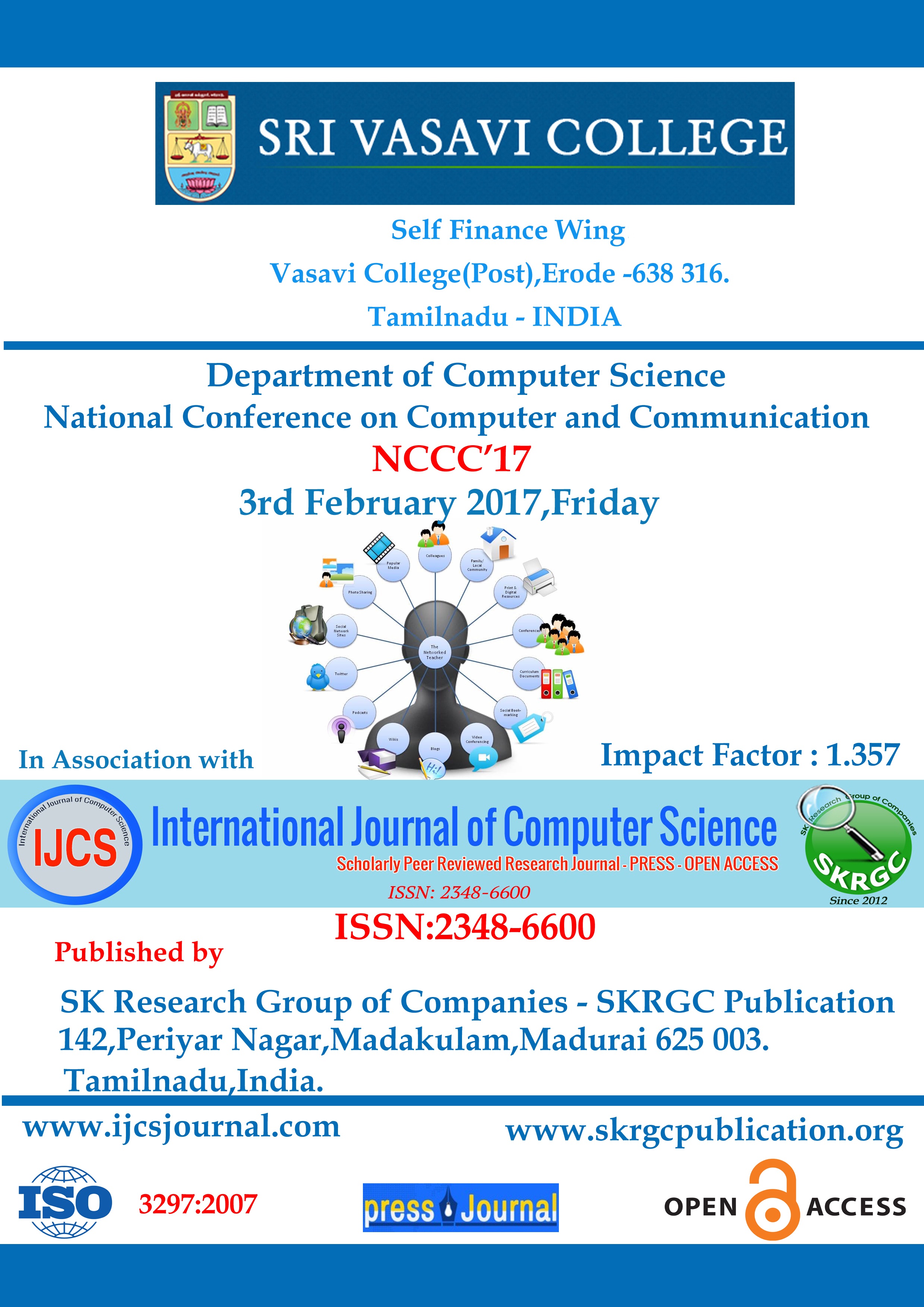Fault Tolerant Sensor Query Framework using Pattern based Data Projection Scheme
Sri Vasavi College, Erode Self-Finance Wing, 3rd February 2017. National Conference on Computer and Communication, NCCC’17. International Journal of Computer Science (IJCS) Published by SK Research Group of Companies (SKRGC)
Download this PDF format
Abstract
The wireless sensor node is a tiny device that is used to capture environment information. Sensor devices are used to capture temperature and pressure details from the environment. The sensor devices are used in hospitals, home and production plants. The main components of a sensor node are microcontroller, transceiver, external memory and power source. A wireless sensor network (WSN) is a wireless network consisting of spatially distributed autonomous devices. Sensors are used to cooperatively monitor physical or environmental conditions. Sensor network is equipped with a radio transceiver or other wireless communications device. The sensor networks are deployed with consideration of sensing and transmission coverage factors. Wireless sensor networks (WSNs) perform the data collection over a large geographic area. Computing and tracking the spatial-average of the sensor measurements are estimated over a region of the WSN. Sensor faults and heterogeneous measurement noise factors affects the sensor data average process. Robust averaging fixed-point iteration algorithm is used to compute a weighted average of sensor measurements with noise and faults. Each sensor performs projections on its sensor measurements to produce a lower bandwidth compressed data stream. Data approximation process is used to assign relevant data values for missed or noisy data values. The sensors in the WSN use random projections to compress the data and send the compressed data to the data fusion centre. The data fusion centre only need to perform decompression once to compute the robust average to reducing the computational requirements. The compressive data collection scheme is enhanced with Bayesian approach to support projection count prediction. Sensing and transmission coverage factors are integrated in the data collection process. Data projection accuracy is improved with frequent pattern identification mechanism. The data collection scheme is tuned to support scheduling schemes to increase network lifetime.
References
[1] Chun Tung Chou, Aleksandar Ignjatovic, and Wen Hu, “Efficient Computation of Robust Average of Compressive Sensing Data in Wireless Sensor Networks in the Presence of Sensor Faults” IEEE Transactions on Parallel and Distributed Systems, Vol. 24, No. 8, August 2013.
[2] A. Ignjatovic, C.T. Lee, P. Compton, C. Cutay, and H. Guo, “Computing Marks from Multiple Assessors using Adaptive Averaging,” Proc. Int’l Conf. Eng. Education (ICEE), 2009.
[3] W. Bajwa, J. Haupt, A. Sayeed, and R. Nowak, “Joint Source-Channel Communication for Distributed Estimation in Sensor Networks,” IEEE Trans. Information Theory, vol. 53, no. 10, pp. 3629-3653, Oct. 2007.
[4] K. Ni, N. Ramanathan, M. Chehade, L. Balzano, S. Nair, S. Zahedi, E. Kohler, G. Pottie, M. Hansen, and M. Srivastava, “Sensor Network Data Fault Types,” Trans. Sensor Networks, vol. 5, no. 3, article 25, May 2009.
[5] C. Luo, F. Wu, J. Sun, and C. Chen, “Compressive Data Gathering for Large-Scale Wireless Sensor Networks,” Proc. ACM Mobicom ’09, Sept. 2009.
[6] S. Lee, S. Pattem, and M. Sathiamoorthy, “Spatially-Localized Compressed Sensing and Routing in Multi-Hop Sensor Networks,” Proc. Third Int’l Conf. Geosensor Networks (GSN), 2009.
[7] S. Ganeriwal, L. Balzano, and M. Srivastava, “Reputation-Based Framework for High Integrity Sensor Networks,” Trans. Sensor Networks, vol. 4, no. 3, article 15, May 2008.
[8] O. Obst, “Poster Abstract: Distributed Fault Detection Using a Recurrent Neural Network,” Proc. Int’l Conf. Information Processing in Sensor Networks (IPSN ’09), pp. 373-374, 2009.
[9] R.K. Rana, C.T. Chou, S.S. Kanhere, N. Bulusu, and W. Hu, “Ear-Phone: An End-to-End Participatory Urban Noise Mapping System,” Proc. ACM/IEEE Ninth Int’l Conf. Information Processing in Sensor Networks (IPSN ’10), Apr. 2010.
[10] C.T. Chou, R. Rana, and W. Hu, “Energy Efficient Information Collection in Wireless Sensor Networks Using Adaptive Compressive Sensing,” Proc IEEE 34th Conf. Local Computer Networks (LCN ’09), 2009.
[11] Y. Shen, W. Hu, R. Rana, and C.T. Chou, “Non-Uniform Compressive Sensing in Wireless Sensor Networks: Feasibility and Application,” Proc. Seventh Int’l Conf. Intelligent Sensors, Sensor Networks and Information Processing (ISSNIP), pp. 271-276, 2011.
[12] M.A. Davenport, P.T. Boufounos, M.B. Wakin, and R.G. Baraniuk, “Signal Processing with Compressive Measurements,” IEEE J. Selected Topics in Signal Processing, vol. 4, no. 2, pp. 445-460, Apr. 2010.
[13]. Benazir Fateh and Manimaran Govindarasu, “Joint Scheduling of Tasks and Messages for Energy Minimization in Interference-Aware Real- Time Sensor Networks”, IEEE Transactions On Mobile Computing, Vol. 14, No. 1, January 2015
[14]. Jing (Selena) He, Shouling Ji, Yi Pan and Yingshu Li, “Constructing Load-Balanced Data Aggregation Trees in Probabilistic Wireless Sensor Networks”, IEEE Transactions On Parallel And Distributed Systems, Vol. 25, No. 7, July 2014
[15]. Muhammad Omer Farooq and Thomas Kun, “Impact of route length on the performance of routing and flow admission control algorithms in wireless sensor networks”, IET Wireless Sensor Systems, Vol. 6, Iss. 1, pp. 10–16, 2016.

